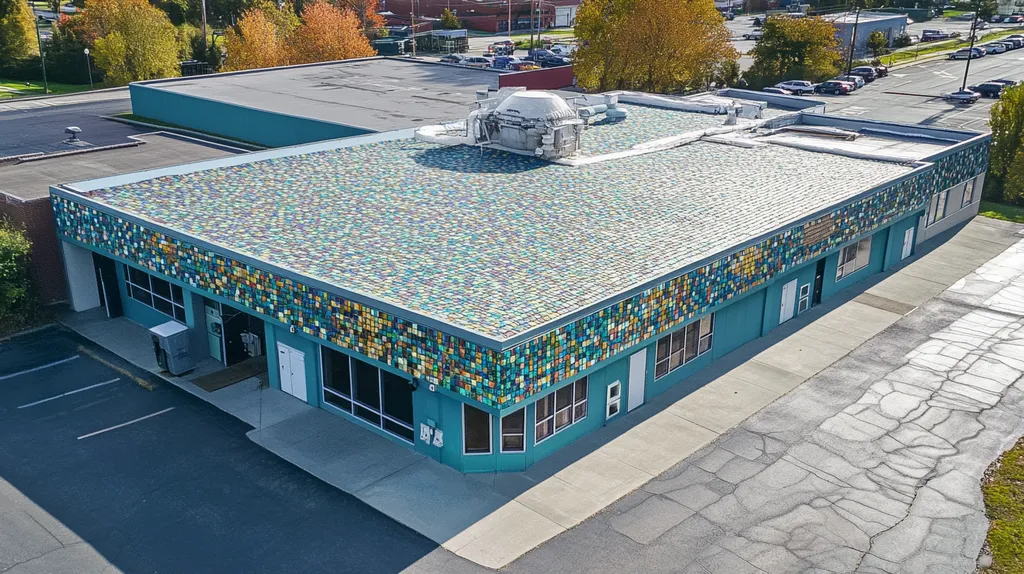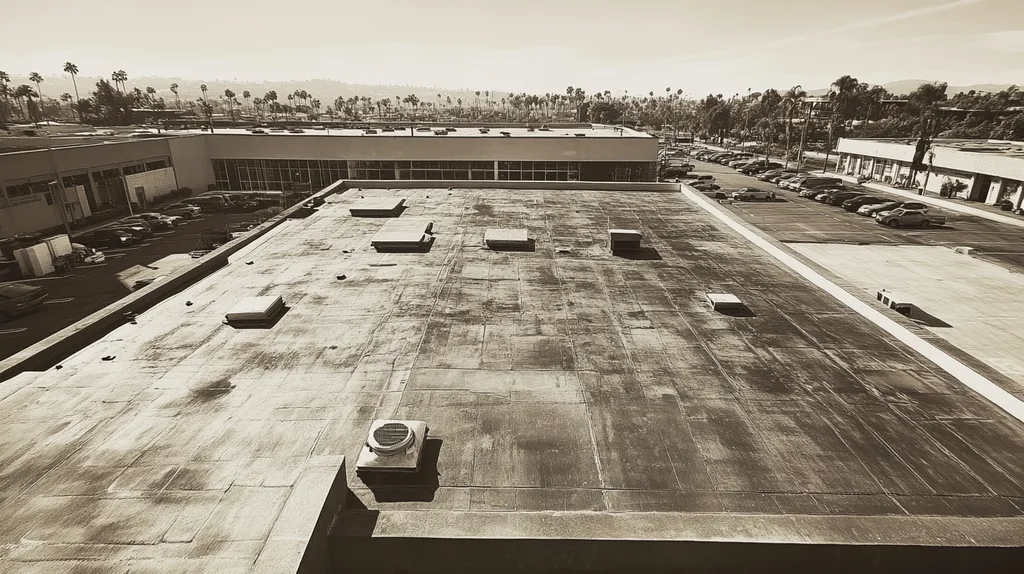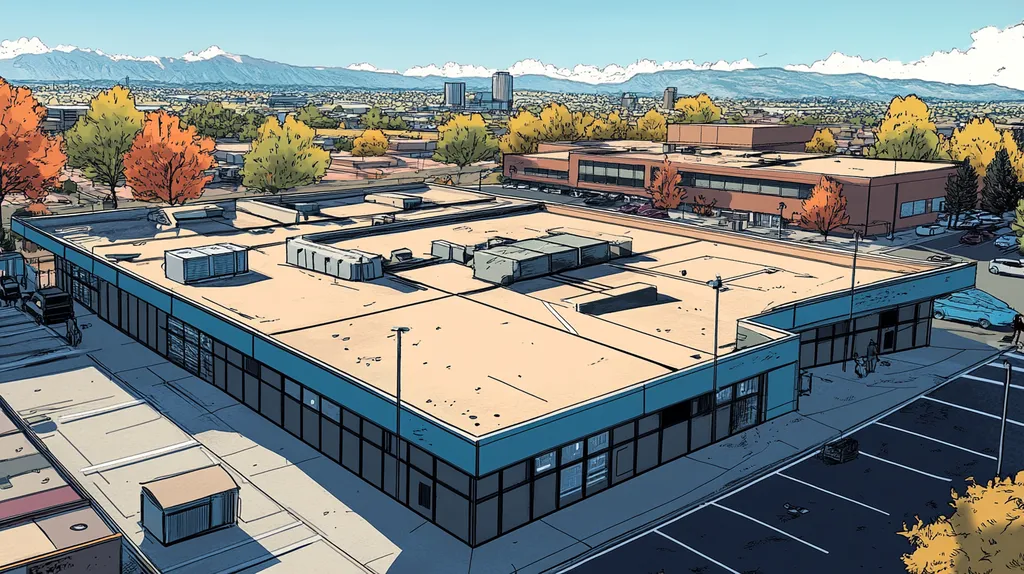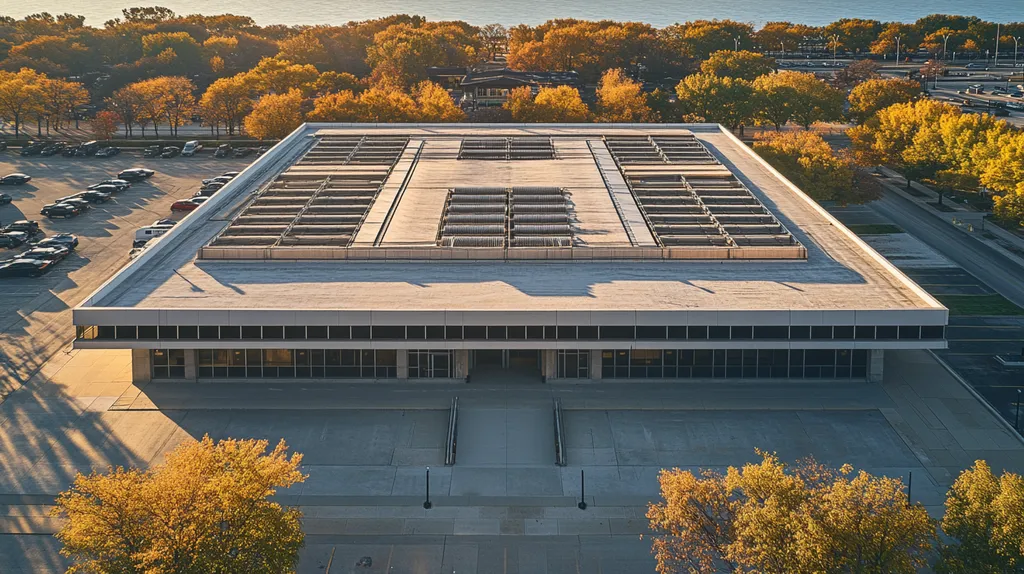Over 80% of commercial roof failures can be traced back to inadequate surface preparation, resulting in billions of dollars in repair costs annually across North America.
While industry standards exist for surface preparation, conventional practices often fall short of delivering the necessary foundation for durable roofing systems.
This analysis examines how traditional surface preparation methods contribute to premature roof failures and explores data-driven solutions that challenge outdated industry norms.
From systemic issues in current practices to missed opportunities in quality control, understanding these critical shortcomings is essential for property owners and facility managers seeking to protect their roofing investments.
SECTION 1: CURRENT PRACTICES
Surface preparation plays a crucial role in ensuring the durability and efficiency of commercial roofing systems. Alarmingly, over 50% of roof failures can be traced back to insufficient preparation, highlighting the importance for property owners to prioritize this essential phase. Many commonly used methods fall short in delivering the necessary cleanliness and adhesion. This section explores prevalent surface preparation practices, the tools and equipment commonly utilized, and the standard cleaning protocols in the industry.
Common Surface Preparation Methods
Today, standard practices for roof surface preparation typically include power washing, scraping, and the application of solvents. Power washing is a popular choice for removing loose debris; however, it can inadvertently push moisture into seams and layers, creating future problems. While scraping effectively eliminates loose materials, it often neglects microscopic contaminants that can greatly impact adhesion.
Solvents are frequently used to clean surfaces, yet their compatibility with different roofing materials can vary widely. Some property owners may unknowingly choose solvents that damage their roofing systems instead of improving them. The failure to incorporate newer technologies in existing practices exacerbates these concerns.
The conventional methods currently in use frequently overlook the unique requirements of modern roofing systems. This oversight can lead to decreased lifespan or unexpected failures, resulting in costly repairs or replacements for property owners.
In this context, many commercial rooftops are on a collision course with premature wear and tear. The industry must acknowledge these shortcomings and strive for more rigorous approaches to surface preparation.
Tools and Equipment Used
Essential tools for commercial roof surface preparation include industrial vacuums, pressure washers, and wire brushes. While these tools serve various purposes, they are not equally effective at removing contaminants that hinder roof performance. Industrial vacuums may collect debris but can miss fine particles that stubbornly cling to surfaces.
Pressure washers, prized for their efficiency, can unintentionally inject contaminants into seams, which may lead to significant problems over time. Wire brushes provide a way to scrape off loose debris, but they may fall short in adequately cleaning the underlying surface.
The reliance on outdated equipment emphasizes an urgent need for modernization within the industry. Innovative tools, such as advanced surface cleaners designed to use less water while enhancing cleaning effectiveness, should be more widely utilized.
Inadequate tools and equipment can compromise thorough cleaning, ultimately undermining the integrity of the roofing system. Property owners and facility managers must invest in modern tools that meet today’s roofing standards.
Standard Cleaning Protocols
Standard cleaning protocols for commercial roofs often consist of sweeping, pressure washing, and the use of chemical cleaners. While sweeping efficiently removes larger debris, it tends to overlook stubborn stains and contaminants that can affect adhesion. Pressure washing offers effective cleaning but requires careful technique to avoid damaging sensitive roofing materials.
Chemical cleaners can enhance surface cleanliness, yet improper usage poses risks of environmental damage and surface degradation. The trend of relying on aggressive chemicals underscores a gap in knowledge about organic alternatives that could be less harmful.
A lack of universal standards results in inconsistent practices, greatly increasing the risk of errors throughout a roof’s lifecycle. Consequently, property owners may find themselves incurring higher maintenance costs and facing shorter roofing system lifespans.
Embracing comprehensive cleaning protocols that feature safer and more effective methods will be vital in enhancing overall roofing performance. As industry standards evolve, stakeholders need to adopt a holistic approach to surface preparation that preserves roof integrity for the long term.
SECTION 2: SYSTEMIC ISSUES
The implications of inadequate surface preparation for commercial roofs are critical. Poor adhesion not only leads to leaks but can also set the stage for expensive damage and potential structural failures. A recent study reveals that nearly 30% of commercial roofing installations encounter adhesion-related issues within just five years. This section will address the pressing concerns around adhesion failures, the harmful effects of moisture and contaminants, and the deficiencies in current inspection processes.
Adhesion Failures and Leaks
Adhesion failures are a key threat to the reliability of commercial roofs. When surfaces aren’t properly prepared, roof membranes can struggle to stick, leaving them vulnerable to environmental elements. This insecure attachment creates gaps that allow moisture to penetrate, leading to leaks.
The consequences of leaks can escalate quickly, damaging insulation, structural components, and interior finishes. Repair expenses can easily climb to tens of thousands of dollars, diverting crucial funds away from other business priorities.
Additionally, adhesion failures can necessitate premature roof replacements, increasing lifecycle costs for property managers. It’s essential to grasp the connection between surface preparation and effective adhesion to maintain roofing performance over time.
Efficient preparation processes are vital in mitigating these risks and extending the roofing system’s lifespan. Investing in superior surface preparation practices is not just wise; it’s a critical financial decision for property owners.
Impact of Moisture and Contaminants
Moisture and contaminants are significant threats to roofing systems. When oils, debris, or humidity are present on the surface before installation, they thwart the adhesion process. This interference can lead to weaker membranes that may fail sooner than expected, increasing the likelihood of leaks.
Research indicates that roofs installed over contaminated surfaces witness a staggering 50% increase in moisture-related issues, driving up repair costs. Often, these contaminants remain hidden until they escalate into more severe issues like mold growth or structural damage.
Implementing strict surface cleaning protocols prior to installation can dramatically reduce these risks. A clean substrate not only improves adhesion but also enhances the longevity of the entire roofing system.
The industry must recognize the importance of addressing moisture and contaminants during surface preparation. By taking decisive action, property managers can ensure their roofing systems function as designed.
Shortcomings in Inspection Processes
Insufficient inspection processes before installation can result in overlooked surface issues. Routine evaluations often miss crucial elements, such as moisture levels and cleanliness. These oversights can culminate in significant failures during the roof’s service life.
It is imperative that industry standards evolve to mandate thorough evaluations. Only with rigorous inspections can property owners be assured of the roofing systems installed on their properties. Failing to adapt inspection practices can have dire consequences.
Utilizing advanced technologies, like moisture meters and infrared imaging, could transform inspection practices. These tools deliver precise assessments, addressing the intricacies of surface preparation that older methods may overlook.
The call for reform is urgent. Property managers should champion improved inspection protocols aligned with best practices to guarantee that surface preparation is conducted effectively and safeguards their investments.
SECTION 3: MISSED OPPORTUNITIES
The failure to address key aspects of surface preparation can lead to severe financial and structural repercussions for commercial properties. According to the National Roofing Contractors Association, inadequate substrate preparation is a major cause of roof failures, costing businesses millions annually. Identifying these missed opportunities is essential for property owners and facility managers focused on prolonging the lifespan of their roofing systems.
Neglecting Substrate Specifics
Property owners often underestimate how critical substrate characteristics are to roofing performance. Each type of roof requires distinct consideration based on the underlying materials—such as concrete, plywood, or metal. Ignoring these differences can result in poor adhesion and diminished functionality.
For instance, a concrete substrate may demand specific treatments that differ from those required for a metal one. If surface properties are not accurately assessed, the application of an incompatible primer or adhesive can lead to premature roof failures. These failures not only incur repair costs but can also disrupt business operations.
To prevent these issues, property owners should work with qualified professionals who can thoroughly examine substrate conditions. This ensures compatibility between roofing materials and the surfaces they cover.
Focusing on substrate characteristics can significantly extend a roof’s lifespan, thereby reducing maintenance needs and maximizing return on investment.
Overlooking Detailed Cleaning
A critical step often neglected is detailed cleaning during surface preparation. A clean surface is vital for effective adhesion of roofing materials, yet improper cleaning techniques can leave behind contaminants like oils, dirt, and old coatings.
For example, using pressure washing without a clear understanding of the substrate can damage sensitive materials, hindering adhesion and creating weak points susceptible to leaks.
Implementing a tailored cleaning protocol that utilizes suitable solvents and appropriate pressure settings is crucial. The cleaning process should be aligned with the specific requirements of the roofing system.
Investing in meticulous cleaning could lead to significant savings for property managers by preventing avoidable damages and enhancing roof durability.
Ignoring Environmental Factors
Environmental factors significantly influence the performance of roofing systems, yet they are often overlooked during surface preparation. Weather conditions, temperature fluctuations, and UV exposure can affect how materials perform over time.
Applying coatings during high humidity or temperature extremes can impede proper curing, adversely impacting adhesion and overall material integrity.
Property managers must remain vigilant about local weather conditions and modify their roofing strategies accordingly. A thorough understanding of environmental conditions allows for better material selection and preparation techniques.
By incorporating environmental considerations, property managers can create more resilient roofing systems, effectively preventing costly repairs and extending the lifespan of their roofs.
SECTION 4: ROOT CAUSES
Effective surface preparation is essential to the longevity of commercial roofs. Alarmingly, improper preparation is responsible for up to 40% of roofing failures, as identified by the National Roofing Contractors Association. Key factors contributing to this problem include inadequate training of personnel, poor material selection, and rushed preparation timelines.
Lack of Proper Training
One of the most pressing issues in surface preparation is the lack of proper training for roofing personnel. Many workers enter the field without sufficient understanding of surface treatment complexities or the newest techniques. This knowledge gap can lead to mistakes in application methods and a poor grasp of different materials’ properties.
Untrained teams may skip critical procedures, such as thorough cleaning and moisture detection, which ultimately weakens the roofing system. For example, if the surface is not adequately prepped, adhesives may fail to bond, resulting in roof failures within a short timeframe.
Moreover, ongoing education is often disregarded. Keeping pace with emerging materials and techniques is crucial to ensuring that workers are adequately trained. By enhancing training programs and certifications, the industry could significantly elevate standards and improve outcomes in surface preparation.
Ultimately, addressing the training deficit is vital for enhancing the performance and lifespan of commercial roofing systems. An educated workforce is key to preventing costly long-term failures.
Inadequate Material Selection
Correct material selection is crucial for successful surface preparation, yet property owners frequently rush this decision. Often, they’re tempted to choose cheaper materials without assessing their compatibility with specific roof conditions. Such decisions can result in material failures and costly repairs.
For example, using mismatched primers or sealers can inhibit a roofing system’s effectiveness, resulting in poor adhesion. This inadequacy allows water to infiltrate and can cause substantial damage. Additionally, traditional materials may not meet modern durability demands, leading to premature roof degradation.
To mitigate these risks, property owners must align their material choices with local climate conditions and building requirements. Consulting knowledgeable suppliers and contractors who understand the nuances of roofing materials is essential to ensure the best decisions are made.
In summary, informed material selection is critical for successful surface preparation. Focusing on quality materials that suit environmental conditions can greatly enhance a roof’s durability and performance.
Rushed Preparation Schedules
While time is of the essence in commercial roofing, hurried surface preparation often results in subpar outcomes. Many contractors operate under tight schedules, which can lead to compromises in quality. This rush can jeopardize the integrity of the entire roofing system.
For instance, if a surface is not completely dried before applying any coatings, moisture can become trapped and lead to serious issues, like blistering and peeling. These problems may not surface immediately but can escalate into significant long-term damage.
In addition, with pressing timelines, essential procedures such as detailed inspections or thorough cleaning may be overlooked. These steps are crucial for establishing a solid foundation for roofing systems and contribute significantly to their performance and longevity.
In conclusion, property owners must advocate for reasonable timelines that allow for comprehensive surface preparation. Investing adequate time in this phase leads to more resilient and durable roofing systems, ultimately protecting their investments.
DATA DRIVEN EVIDENCE
Improper surface preparation for commercial roofs can lead to serious safety hazards and costly financial repercussions. Recent industry studies indicate that more than 30% of roofing repairs fail within their warranty period due to subpar surface preparation practices. Such failures not only lead to hefty repair bills but also compromise the structural integrity of the entire roofing system. This section reviews vital statistics on repair failures, analyzes case studies of inadequate preparations, and evaluates the financial impact of improper surface treatments.
Statistics on Repair Failures
According to a 2022 report from the National Roofing Contractors Association, around 34% of commercial roofing repairs stem from issues linked to surface preparation. This statistic highlights the urgent need for improved practices within the industry.
Additionally, the average cost of a repair resulting from inadequate surface preparation can exceed $10,000, demonstrating both the financial impact and potential disruptions to business operations.
Furthermore, nearly 60% of facility managers noted that recurring leaks directly arose from improper surface conditions before installation. Addressing these preparation challenges holds the key to boosting long-term roof performance.
These statistics underscore a critical focus area for property owners aiming to maximize the longevity and effectiveness of their roofing systems.
Case Studies of Failed Repairs
Take, for instance, a case involving a large retail facility in the Midwest that faced persistent roof leaks. Investigations revealed that the underlying surface had not been adequately cleaned before a new membrane was installed. This oversight trapped moisture, leading to mold growth and substantial interior damage.
In another example, an industrial warehouse suffered from premature membrane failure due to an absence of proper priming materials. The facility manager reported expenses exceeding $50,000 for extensive water damage repairs following these failures.
These instances highlight the vital role that comprehensive surface preparation plays in averting costly long-term issues. Without addressing these foundational tasks, property owners can incur significant repair and restoration costs.
Each failed repair serves as a stark reminder that investing in effective surface preparation is not just beneficial; it is essential for ensuring the long-term success of roofing systems.
Cost Analysis of Improper Preparation
The financial burden of improper surface preparation can significantly inflate overall roofing costs. A review of various roofing projects revealed that facilities that cut corners on preparation work tend to incur approximately 50% more in repair costs within five years of installation.
These hidden costs not only encompass emergency repair labor but also account for the business downtime associated with such disruptions, which can seriously impact cash flow. Neglecting surface preparation turns out to be a misguided cost-saving strategy, often leading to greater expenses.
Analysis indicates that roofs lacking proper preparation exhibit a failure rate that is double that of well-prepared surfaces. This stark contrast illustrates the financial implications of overlooking essential preparation work.
In conclusion, proper surface preparation can lead to long-term savings and enhanced durability. Making informed decisions at the outset can protect both the roof and the bottom line.
SECTION 6: ALTERNATIVE SOLUTIONS
In an industry where roofing failures can lead to costly damage and operational disruptions, finding innovative surface preparation solutions is essential. Research indicates that inadequate surface preparation can decrease a roofing system’s lifespan by up to 30%. Property owners and facility managers should consider advanced methods that not only boost durability but also conform to best practices for safety and efficiency. This section examines advanced cleaning techniques, specialized substrate preparation, and integrated quality control measures.
Advanced Cleaning Techniques
Traditional cleaning methods typically rely on high-pressure washing, which can inadvertently leave behind contaminants that compromise adhesion. In contrast, advanced options, such as steam cleaning and environmentally friendly chemical removers, have emerged as safer and more effective methodologies. These techniques remove dirt and debris while sanitizing surfaces to minimize mold growth.
Infrared cleaning technology presents another innovative solution. This process uses heat to dislodge contaminants without harming the roofing membrane. Increased cleaning efficiency leads to time savings, streamlining the overall installation process.
By adopting these advanced methods, the quality of surface preparation can be significantly improved. Cleaner surfaces enhance adhesion for the roofing materials that follow, ultimately resulting in installations that last longer. As safety and longevity become top priorities for property owners, these advanced cleaning techniques are increasingly viewed as necessary features rather than optional extras.
Investing in state-of-the-art cleaning solutions underscores a commitment to sustainability. By adopting eco-friendly practices, businesses can satisfy regulatory requirements while also benefiting their bottom line.
Specialized Substrate Preparation
Surface preparation encompasses more than just cleaning; it requires thorough assessment of substrate conditions. Conventional practices often overlook the importance of evaluating substrate integrity prior to installation. By utilizing specialized substrate preparation techniques, the overall performance of the roofing system can be significantly enhanced.
For example, moisture-mapping technologies can identify concealed water infiltration issues before installation begins. This proactive approach enables the application of necessary corrective actions to secure the substrate. Additionally, specialized primers are available that can improve adhesion and protect against environmental challenges.
The choice of fasteners must also be optimized according to substrate conditions. Selecting the appropriate materials, whether galvanized or stainless steel, based on the substrate composition, contributes to a more resilient roofing system.
Prioritizing specialized substrate preparation minimizes the risk of costly repairs in the future. The long-term benefits of such tailored preparations outweigh the initial investment, providing property managers with significant cost savings.
Integrated Quality Control Measures
Quality control is often neglected in conventional surface preparation practices, yet it can be pivotal to success. Implementing structured quality control measures, including routine inspections and adherence to manufacturer specifications, can make a significant difference.
Incorporating third-party assessments enhances credibility, ensuring that all preparation steps meet the highest standards. These evaluations enable identification of potential weaknesses before they lead to major issues.
Documenting each phase of the surface preparation process creates a clear accountability record. This transparency helps build trust with property owners and can prove invaluable during insurance evaluations or property assessments.
By focusing on integrated quality control, facility managers can ensure that roofing systems perform as intended. Effective quality control not only protects the initial investment but also contributes significantly to the durability of the entire roofing system.
The Bottom Line
With over 80% of commercial roof failures traced to inadequate surface preparation, the industry can no longer afford to maintain conventional practices that cost billions in repairs annually.
The data clearly demonstrates that traditional cleaning methods, rushed schedules, and poor training contribute significantly to premature roofing failures.
Advanced cleaning technologies, specialized substrate preparation techniques, and integrated quality control measures offer proven solutions to these persistent challenges.
Property owners and facility managers who embrace these evidence-based approaches can expect to reduce repair costs by up to 50% while extending roof lifespans by 15-20 years.
The time for revolutionary change in commercial roof surface preparation is now – the financial and structural stakes are simply too high to ignore.
FREQUENTLY ASKED QUESTIONS
Q. What are current practices for preparing a commercial roof?
A. Current practices include methods like power washing, scraping, and solvent application. Unfortunately, these techniques often fail to remove microscopic contaminants and can lead to issues like poor adhesion and eventual roof failure due to improper cleaning. Without proper surface preparation, the roof’s longevity and functionality can be compromised.
Q. How do adhesion failures affect the lifespan of a commercial roof?
A. Adhesion failures can significantly shorten the lifespan of roofing systems by allowing moisture to penetrate and lead to leaks. These leaks can escalate repair costs dramatically, causing damage to insulation and structural components. Good adhesion is critical for maintaining the integrity of commercial roofs over time.
Q. What missed opportunities can affect an industrial roof’s durability?
A. Neglecting specific substrate characteristics and proper cleaning can drastically shorten the lifespan of an industrial roof. Inadequate substrate assessment often results in poor adhesion, leading to increased maintenance costs. Addressing these aspects early can save property owners significant sums and enhance their roof’s performance.
Q. Why is proper training important for commercial roof preparation?
A. Proper training ensures that roofing personnel understand the complexities of surface preparation. Untrained workers may overlook critical procedures, resulting in inadequate cleaning and increased risks of adhesion failure. Investing in ongoing education enhances workforce competency and helps prevent costly long-term issues.
Q. What are the financial impacts of improper surface preparation?
A. Improper surface preparation can inflate overall roofing costs significantly, with facilities seeing 50% more in repair expenses due to inadequate practices. This includes not only immediate repair costs but also longer-term impacts like business downtime that can disrupt cash flow. Proper preparation is essential for protecting financial investments.
Q. What alternative solutions exist for effective commercial roof preparation?
A. Alternative solutions like advanced cleaning techniques, specialized substrate preparation, and integrated quality control measures can significantly enhance the surface preparation process. Products like steam cleaners and moisture-mapping technologies improve cleaning efficacy and ensure adherence to best practices. Investing in these methods boosts the durability and longevity of roofs.
Q. How can you identify the right materials for a commercial roof?
A. Selecting the right materials involves assessing compatibility with specific roof conditions and environmental factors. Consulting knowledgeable suppliers and conducting thorough evaluations ensures that the materials meet performance standards. Informed decisions will enhance roof durability and limit future repair needs, contributing to overall cost-effectiveness.











